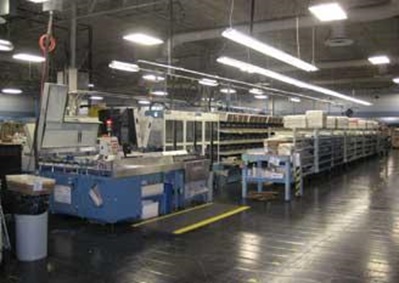Engineering Controls Database
U.S. Postal Service Contaminant Controls – Delivery Bar Code Sorter
|
In 2001, terrorist attacks took place where anthrax spores were sent by mail to a U.S. Senator and to media offices [CDC 2001]. These attacks resulted in exposure to anthrax spores by postal employees working in a mail processing facility that serves the U.S. Capitol and resulted in inhalation disease in several of the workers [Mayer et al. 2001]. One potential area of exposure in the United States Postal Service (USPS) is the automated mail processing equipment used to sort incoming mail. As the mail passes through the machinery, it is compressed and impacted in a number of places that could cause release of substances from the mail. |
|
| Bacillus anthracis is a large spore forming bacteria. In the vegetative state, it is rod shaped and ranges in size from 1-1.5 X 3-10 µm. The anthrax spores are typically in the 1-5 µm size range and can enter the body by being inhaled, through the skin, or through ingestion. Disease occurs when spores enter the body, germinate, and multiply. The cutaneous form of the disease generally develops 2-5 days following exposure and can usually be successfully treated with antibiotics. The onset for the inhalation form is typically l-6 days after exposure. The inhalation form generally has a high fatality rate even with appropriate treatment [Pile et al. 1998]. | |
|
Researchers from the National Institute for Occupational Safety and Health (NIOSH) were requested to assist the USPS in the evaluation of particulate controls for various mail processing equipment. These new controls are being installed to reduce operator exposure to any potentially hazardous contaminants emitted from letter mail during normal mail processing. This effort is driven by the terrorist attacks which used the mail as a delivery system for anthrax. In this report, NIOSH researchers evaluated the performance of the Ventilation and Filtration System (VFS) on the Delivery Bar Code Sorter (DBCS) (Figure 1) during three separate field surveys at the Dulles, Virginia Processing and Distribution Center. The VFS has been designed and installed for the USPS by the DBCS manufacturer. The VFS was designed to reduce emission of biological contaminants (such as spores of B. anthracis) into the ambient atmosphere through use of local exhaust ventilation (LEV) and air filtration units. Additionally, the VFS was designed to reduce machine down time and maintenance caused by paper dust accumulation.  Filtration System The VFS manufacturer claims that the filtration system of the VFS will remove particles as small as 0.5 micron with an efficiency of 99.999% and particles as small as 0.3 microns with an efficiency of 99.97% with a combination of a primary (standard filter) and high-efficiency particulate air (HEPA) filters. According to the manufacturer, the primary filter cleans itself automatically and needs to be changed every 1 to 5 years, while the HEPA (secondary) filters must be changed about every 3 to 4 years. Moreover, the manufacturer states that the filtration unit generates noise to a level of about 80 dBA at five feet from the floor at a distance of one foot from the platform edge of the filtration unit. The floor space required for the Collection, Vacuum and Filtration Unit is about 6ft by 10ft. Dust Collection Unit The manufacturer's strategy for dust collection was, in part, to modify access covers of the machines in order to totally or partially enclose the source of contaminant and control the direction of airflow into the machine. Letter transport locations such as the Transport Module and Feeder Module were fitted with vented covers, where needed, to surround dust-emitting areas. In applicable Transport Module locations, turbulent induction methods were used to prevent dust particles from settling. In the Stacker Modules, clear, polyvinyl curtains were installed to reduce airflow area and increase capture velocities, as well as to reduce sound emissions while permitting worker access to remove mail. The rear doors of the Stacker Modules, not accessed during normal operation, were fitted with slotted plenum structures to more evenly distribute the flow of air at the front, working side of the Modules. |
|
| 279-11A; 279-17A; | |
|
CDC (Centers for Disease Control and Prevention) [2001]. Investigation of bioterrorism-related anthrax and interim guidelines for exposure management and antimicrobial therapy. MMWR 50:909-919. Mayer TA, Bersoff-Matcha S, Murphy C, Earls J, Harper S, Pauze D, Nguyen M, Rosentahal J, Cerva D, Druckenbrod G, Hanfling D, Fatteh N, Napoli A, Nayyar A, Berman EL [2001]. Clinical presentation of inhalation anthrax following bioterrorism exposure. JAMA 286(20): 2549-2553. Pile JC, Malone JD, Eitzen EM, Friedlander AM [1998]. Anthrax as a potential biological warfare agent. Arch Intern Med 158:429-434. |
|
| 333318 | |
|
anthrax anthrax delivery bar code sorter delivery bar code sorter engineering control engineering control mail handlers mail handlers United States Postal Service United States Postal Service |
|
|
NIOSH researchers made evaluations of the controls based on a variety of tests including particle count measurements, air velocity measurements, smoke release observations and tracer gas experiments. Testing indicated the following regarding DBCS locations targeted by the VFS: • At the Vibrator Module, capture efficiency ranges from about 89% to 99% under normal working conditions; • At the Feeder Table, efficiency is about 76% under normal conditions; • The Feeder Module has capture effectiveness of about 99%; • At the Stacker Modules, efficiency ranges from about 97% to 99%; and • With overhead ceiling fans on, there is some evidence that the VFS efficiency marginally decreases at the Stacker Modules, Vibrator Module and Feeder Table. |
